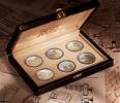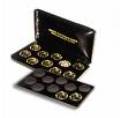
 |
 |
 |
 |
Collecting Coins Reviews
What Are Remints And Mint Marks
On Mints and Mint Marks
Mint Marks are tiny letters referring to the locality where the minting of coins took place. The position of mint mark can be set up typically on the back side of coins that were minted before the year 1965 and on the grandstand play adjacent the instance 1967.
Coins of every US mint branch are recognized by mint marks. These coin marks competition back to ancient times in Rome and Greece.
The “Director of the Mint”, through the “Act of March 3, 1835”, set rules to classify and distinguish the coins released from every US Mint branch. This core management set accurate standards and pattern of production as well as responsible coinage.
Coins that minted at the “Philadelphia mint” earlier than the year 1979 have no mint marks. So it was in that epoch that the dollar was marked with the letter P and other denominations had that same spot thereafter.
All dies for US coins are produced at the “Philadelphia Mint” and prior to shipping the coins to their mint branch, coins are marked first with the correct and designated mint markings. The unvarnished size and positioning of the coins’ mint mark can slightly vary; this is influenced by how unfathomable the punch was impressed and setting.
The importance of mint marks:
Collectors can determine the value of a coin though mint mark, date and character examination, making the coins condition the most significant factor and simple when determining its value.
Defining the Mint which hit the coin is tremendously important in determining the value of the coin; the coin can be hit in huge quantities at a single Mint or in smaller quantities in another hit.
The process of minting:
1. The making of metal strips in the correct thickness: Zinc strips are used for pennies, alloy strips composed of nickel ( 25 % ) and nickel ( 75 % ) for nickel and dollars, half - dollars, dimes, half - dimes are fabricated from a fusion of three coatings of metals; the external layer are alloys and the meeting place is copper.
2. These strips of metals are then put into “blanking presses” that are authoritative for cutting “round blanks”, approximately the dimension of the “done” coin.
3. The blanks inasmuch as are softened by running them through an annealing furnace, through tumbling barrels, and then through revolving cylinders containing chemical mixtures to burnish and clean the metal.
4. The blanks then are washed and placed into a drying device, then into the " upsetting " machines, that produce the raised rim.
5. The Final progress: “coining press”. Each fly speck is clasp into position by a collar or outcry as it is being struck or hit under great pressure. Pennies need approximately40 tons of pressure and the larger coins need more. The “upper and lower dies” are stamped simultaneously on the two sides of each coin.
The design:
The “Director of the Mint” chooses the design and pattern for United States coins, then that is approved by the “Secretary of the Treasury”; congress liability recommend and suggest a design. The design ergo burden not be changed for twenty five years unless directed by the congress.
All emblems of United States coins minted currently represent previous presidents of the United States. President Lincoln is on the one - cent coin, adopted in the year1909; Washington on the 25 cent coin that was minted first in 1932; Jefferson on the five cent coin in 1938; Franklin Roosevelt on the dime, introduced in the year1946; Kennedy on the half dollar that was first minted in 1964.
The “Act of 1997” known as the “50 States Quarters Program” supports and allows the redesigning of the quarters - the reverse side is to show each of the fifty states emblems. Every year starting in 1999 and until 2008, coins honoring five states, having designs that are created by each state, will exhibit issued in the sequence or manner in which each state signed the Physique.
The phrase " In God We Trust " was used first in 1864, on a United States two - cent coin. It then was seen on the quarter, nickel, half - dollar, silver dollar and on the $10, $5 and $20 in 1866; in 1909 on the penny, in 1916 on the dime. Today, all United States coins carry the motto.
Share This With Your Friends |
What Affects The Value Of A Coin
Guide For Rare Coin Collectors
Pros And Cons Of Buying At Auction
What You Should Look For In A Coin
How To Avoid Shysters And Fraud
More Collecting Coins Articles
... accumulating different kinds of coins and stamps but also personify the preservation of a nation s history. Both stamp and coin collecting highlight the different images that are used to visually record a significant event or era in history. The two have become indistinguishable as far as value and appeal ...
... light reflected in the high points to the other parts of the coin, an Almost Uncirculated coin is separated from the Mint State coins. 3. Fine Coins These can further be classified as Violently Fine ( 40, 45 ), Very Fine ( 20, 25, 30, and 35 ) or Fine ( 12 ) depending on the sharpness of the remaining ...
... with the hope of exchanging it for another coin of equal or greater value. The ideal coin collection software program should have good search capability, unlimited number of entries and other special features. By checking the various programs and trying some, the person will find the right one needed ...
... currencies from other countries. If a person decides to dispose of some of the coins in the collection, it is necessary to know its value by looking at a coin catalog or price guide. There are many ways to do this and one is looking for a coin dealer to do business with. There are a lot of coin dealers ...

|
| Copyright © 2006-2012 Internet Marketing Tools, All Rights Reserved |